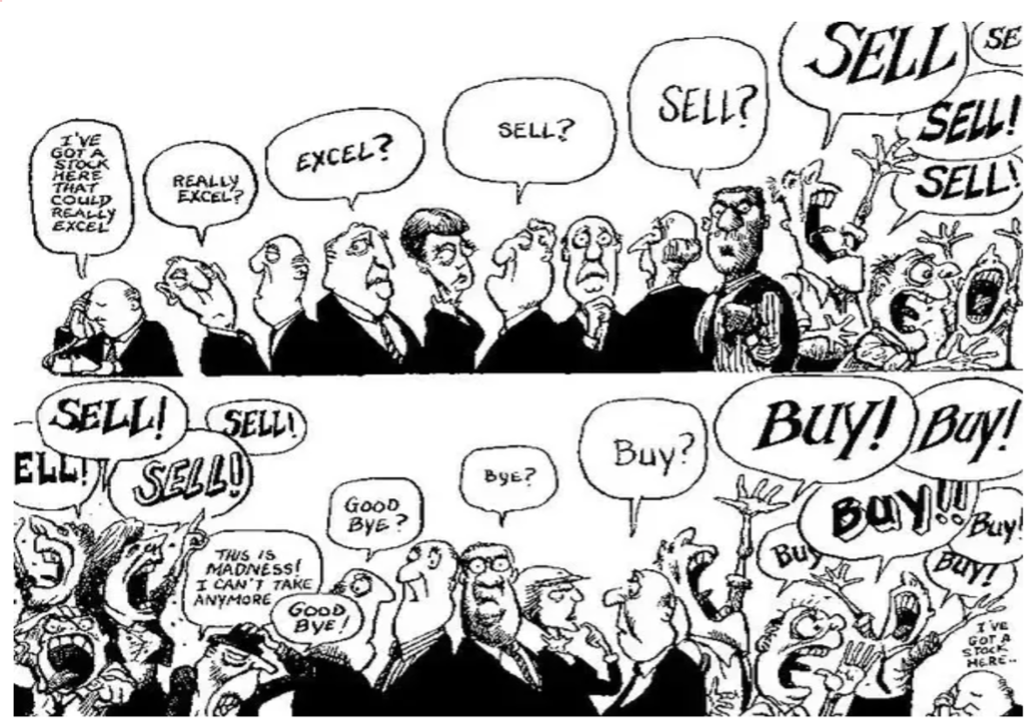Intense Negativity Behind Us, Market Anxiety Remains
Monthly Market and Economic Update – May 2023

Peter Flannery Financial Adviser CFP
“If you have one economist on your team,
it’s likely that you have one more than you’ll need.”
Warren Buffett
Key Points:
- Markets tracking up.
- US Fed raises interest rates another 25 basis points.
- Markets want interest rate cuts this year!
- Inflation will probably remain sticky.
- Where is the investing opportunity?
- What about New Zealand?
THE MARKETS
Markets nervous but tracking up

The above image highlights consensus views around certain aspects across the markets. It will be interesting to see how it all plays out. [Source: Visual Capitalist]
Trends and predictions are interesting, although can be of questionable value when it comes to actually making money.
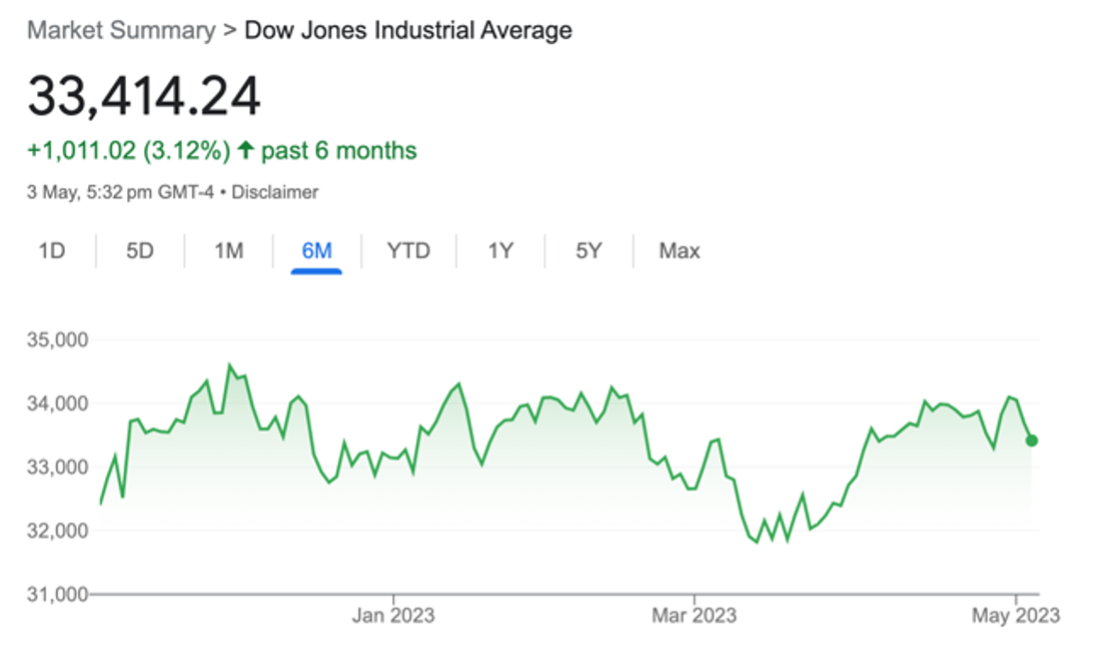
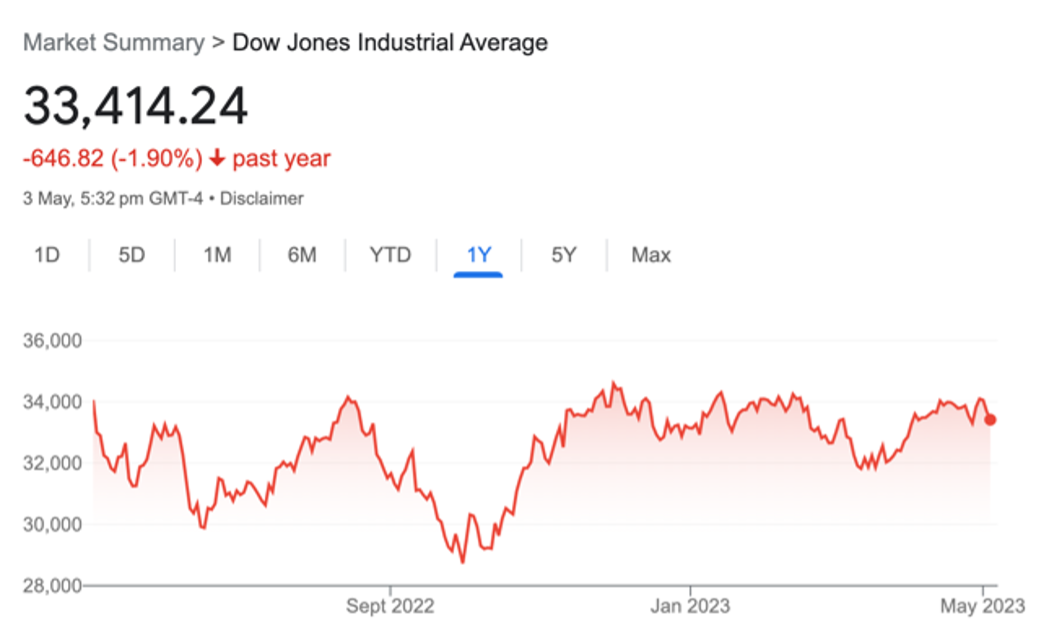
The chart on the left shows the US share market (the Dow Jones) over the last six months. The chart on the right shows the US share market (the Dow Jones) over the last year. [Source: Google Finance]
As you can see from the graph above showing movement in the Dow Jones Industrial index in America, markets have been tracking generally in an upward direction since September 30, 2022.
Whilst it’s difficult to time markets and predict future events, what does work well is to invest in the midst of uncertainty, over time, in quality assets.
One thing to watch currently is the market’s interpretation of what’s going on with inflation and interest rates in the US. In short, the market is hanging on to the idea that the US Federal Reserve will not only stop raising interest rates, but will actually cut interest rates at some point in 2023 – possible, but unlikely in my opinion.
The real point here is that we need to be mindful that we don’t simply go along with the market’s wishful thinking that interest rates will be cut, only to see disappointment suddenly emerge in the form of sharply declining market prices.
Markets are forward-looking. The market is always looking ahead to the next angle or the next opportunity. It also looks ahead for danger.
Currently, there is a question around how much interest rate cuts in the US are built into share prices?
On balance, we may see inflation remain sticky, in which case interest rates may remain higher for longer. Rate cuts in that environment may be further out into the future.
Earnings – USA
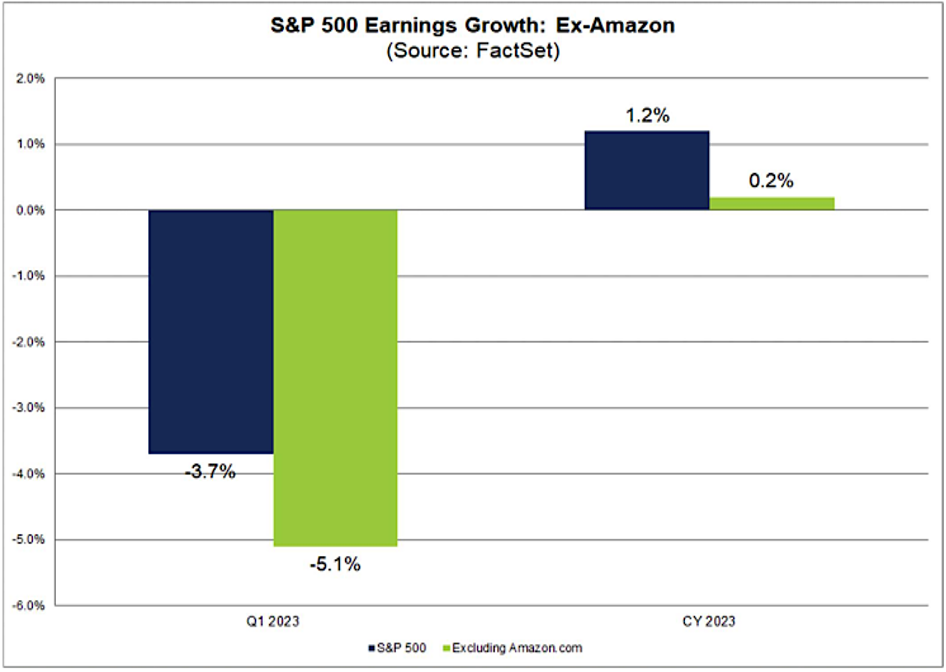
The above graph shows earnings ‘growth’ including and excluding Amazon earnings, over the first quarter of 2023 (Q1 2023) and for the calendar year 2023 to date (CY 2023).
Over the last 6 months or so, I’ve been reporting earnings declines across the American market generally.
We can see from the graph immediately above that earnings across the markets are down overall by about 3.7% (or down by 5.1% if you exclude Amazon’s results).
This is a notable decline but not significant.
This means that a number of companies are making less money. That said, this tends to be for a limited period of time – what do you think that means for us as investors?
However, if I’m investing in the stock market and playing the markets, I will be concerned because lower earnings mean lower trading prices. If I’m playing the market, what I want to see is trading prices rising in an upward direction all day long, all of the time.
A significant earnings miss (an earnings announcement that doesn’t meet expectations) can highlight an underlying problem that hasn’t been obvious to the market. That’s when you’ll see the trading price drop sharply and may or may not be a real business problem.
Sometimes the market is right about driving share prices up or down. Just as often, the market is not right because the stock price does not always reflect what is actually going on below the surface in the underlying business, particularly in the short term.
“In the short term, the money you make will be based on the voting machine (market sentiment). The longer you invest, the more that the money you make will be based on the weighing machine (the underlying fundamentals of the business).
– Ben Graham and Warren Buffett
At WISEplanning, we do not play the market. We invest in the business.
Therefore, we actually don’t mind if trading prices decline.
Trading price declines because the company’s profit has declined or turnover may have declined, whilst not ideal, can be short-term signals that represent a buying opportunity when we look across the economics of the business, beyond the financials.
Anyway, what we know is that earnings (profits) have declined across the US market this year. Although I haven’t shown it in a graph here, I can advise though that the total amount of money that all companies in America have earned over 2022 and so far in 2023, is not far away from all-time highs.
So, the earnings decline generally is not ideal but of limited concern.
Banks – US
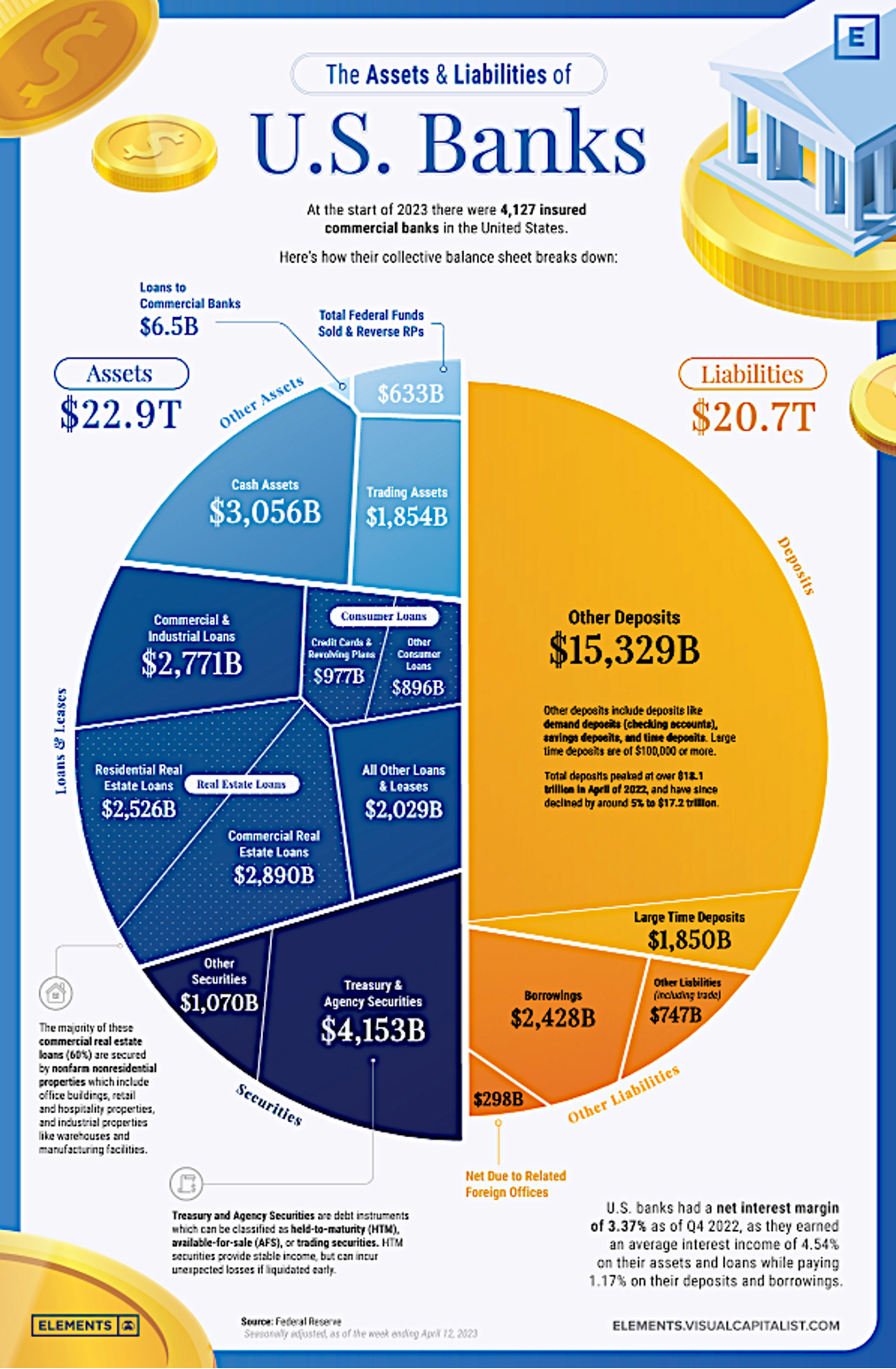
The above infographic looks at all of the deposits, loans, and other assets as well as liabilities that make up the overall balance sheets of US banks (using data from the US Federal Reserve).
Banks need to balance their assets and liabilities to stay in business and remain solvent. To some degree, this relies on the trust of depositors, especially when uncertainty and fear emerge about the security of the money in the bank.
Banking can be a confidence game. You may start to wonder when you think about it, how the security of your money in a term deposit is based on your next door neighbour and whether he or she is feeling scared or not! Sometimes it pays not to overthink things.
Anyway, when we look at First Republic Bank, a recent potential bank failure in America, depositors pulled out more than $101 billion over the first quarter of 2023. This amounted to more than 50% of their total deposits.
In this situation, some of America’s larger banks injected approximately $30 billion in deposits on March 16th, keeping the bank ‘in play’, so to speak. As an aside, one of the problems with banks is a bit of mismanagement whereby they’ve held long-dated bonds that are not easily cashed up or, if they are, are done so at a significant discount (loss).
In simple terms, if interest rates are sitting at 3% but then interest rates rise to, let’s say 5%, then you’re not going to invest at 3%. No, you’ll want to invest at 5%.
This means then that the money invested at 3%, in theory, is worth less than the money invested at 5% because the capital generating a 3% return is less valuable than that capital generating 5% – makes sense?
Term deposits generally can’t be broken and run to maturity.
Bonds on the other hand, can be liquid and sold up at any point.
When that happens, they reflect the level of current interest rates.
For those that cash up bonds after interest rates have gone up, they will receive back less than their original investment.
They can ride it through to maturity to get all their money back (plus the coupon/interest).
You can see then how some banks have mismanaged the situation by investing in long-dated bonds, which has meant if there was any fear in the markets like we’ve seen in some smaller banks in America, then they are unable to pay out depositors the full amount on demand. If depositors though, were prepared to wait for a few years, then they would get all their money back, and no one would be out of pocket.
Of course, when people are fearful, they demand immediate action (are not wanting to wait minutes, let alone years!).
It is entirely possible that other small banks in America could face challenges in the future due to their lack of liquidity. As we saw with the First Republic Bank, other banks stepped up and avoided a bigger problem. So, although this risk has not completely gone away, it appears to be now less problematic than even a few weeks ago.
The fear of a repeat of 2008, which you may recall was a global credit crunch, looks as though it has been averted at the moment. Some may argue that it could’ve become very ugly which of course is always possible. That said, there’s nothing to be gained by governments and central banks these days to allow those events to get out of control.
As far as markets are concerned then, looking into the future, I continue to see choppy sideways ahead. Although possible, I’m not seeing interest rate cuts in 2023, hence ongoing choppy sideways.
That doesn’t mean to say though, that there is no opportunity for us to invest. We’ll be looking at quality businesses whose trading prices represent reasonable buying, regardless of ongoing ‘choppy sideways’.
The Global Economy
A Brief Introduction
Regular readers of Peter’s monthly Market and Economic Updates will be aware of his fondness for Warren Buffett’s quote stating that “If you have one economist on your team, it’s likely that you have one more than you’ll need”.
I am pleased to inform regular readers that I am in fact not strictly an economist having trained in the dark arts of Political Economy at the University of Otago (politics, yuck!) and International Trade at Victoria University of Wellington.
I bring a perspective grounded firmly in the Post-Keynesian tradition of macroeconomics. What this means, amongst other things, is that I value the intrinsic role of the financial system in stabilising (and eventually destabilising) economies. In a phrase, stability is destabilising over the long term.
I hope that you, like me, will find these insights interesting. With that brief introduction aside, let us crack into it.
– Morgan Edwards
The Global Economic Outlook
In a word, I believe that ‘troubling’ sums up the current state of the global economy.
For this reason, I haven’t provided one singular graph as I don’t believe that one graph alone can convey the complex tapestry of the global economy at present.
There continue to be glimmers in the sand, and I’ll touch on those on our whistlestop tour of the international economy. However, significant pressures and issues still remain. Where we end up, who knows, but it is clear that we will continue to face tough times economically for a time yet.
Since the publication of the last monthly economic update, the International Monetary Fund (IMF) have released their half yearly Financial Stability and World Economic Outlook (WEO) reports.
The essence of these reports is that ‘tentative signs in early 2023 that the world economy could achieve a soft landing have receded somewhat amid stubbornly high inflation and recent financial sector turmoil’. Choppy sideways for markets remains the order of the day.
These global dynamics contextualise the wider macroeconomic environment and the policy decisions made by policymakers to ameliorate the impacts of these dynamics on both their citizens and markets and will continue to define the dynamics of the international economic system.
These have come to the fore in recent weeks with the collapse of Silicon Valley Bank (SVB) and the controversial rescue of Credit Suisse by UBS. These dynamics demonstrate that risk is still with us as we have seen with other smaller regional banks facing potential liquidity problems.
The Outlook for Global Interest Rates Remains Cloudy
The IMF WEO noted that global headline inflation is set to decline from 8.7% evident in 2022 to 7.0% in 2023.
While many will attribute this to the precipitous increase in interest rates by central banks globally, the ‘real’ reason lies in the adjustment of market dynamics, such as commodities, to international events such as Russia’s invasion of Ukraine.
Uncertainty still reigns supreme and with the crystal ball cloudier than ever, it is likely that stubbornly persistent (albeit lower) inflation will result in central bankers overestimating the efficacy of interest rates in combatting inflation.
This will likely result in further market turbulence that will continue to test the stability of markets.
The United States of America
The American Dream
The United States has faced some hurdles lately. One such instance was the aforementioned collapse of SVB, with some commentators fearing a 2008 Redux.
While we appear to have dodged the worst for now, recall that the collapse of Bear Stearns in early 2008 appeared to be an isolated incident which was quickly forgotten with the OECD noting that the economic outlook for 2008 looked ‘quite benign’.
Inflation in the United States
Beginning with wage inflation in the United States, the Financial Times (FT) Chart of the Week showed that low wage earners in the United States enjoyed their fastest wage growth in years. The graph is shown below.
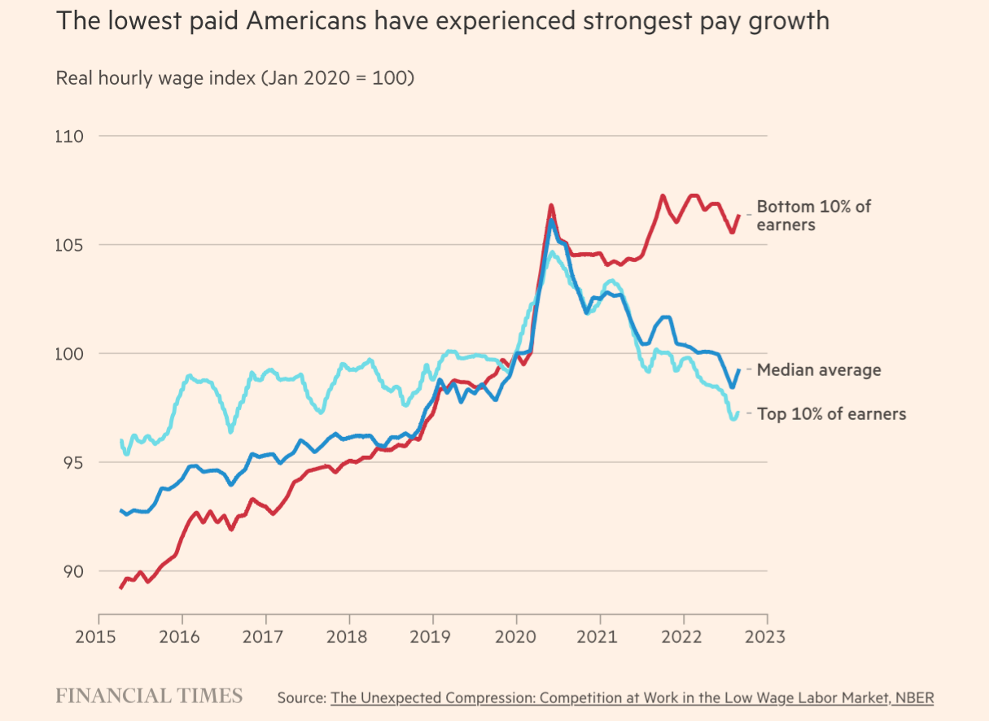
The graph above illustrates pay growth for the top and bottom 10%, and the median average of earners in the United States. Namely, it shows that the earnings of the bottom 10% of earners have increased after 2021.
Does this mean that inflation is going to continue to spiral ever higher?
On its own, of course not. Low-income earners in the US and around the world continue to have less and less influence on macroeconomic dynamics.
Nonetheless, data such as this may continue to influence interest rate decision-making. For interest (rate) sake, here is the effective Federal Funds Rate from January 2020 to the present (not including the 25 basis point rise on May 3).
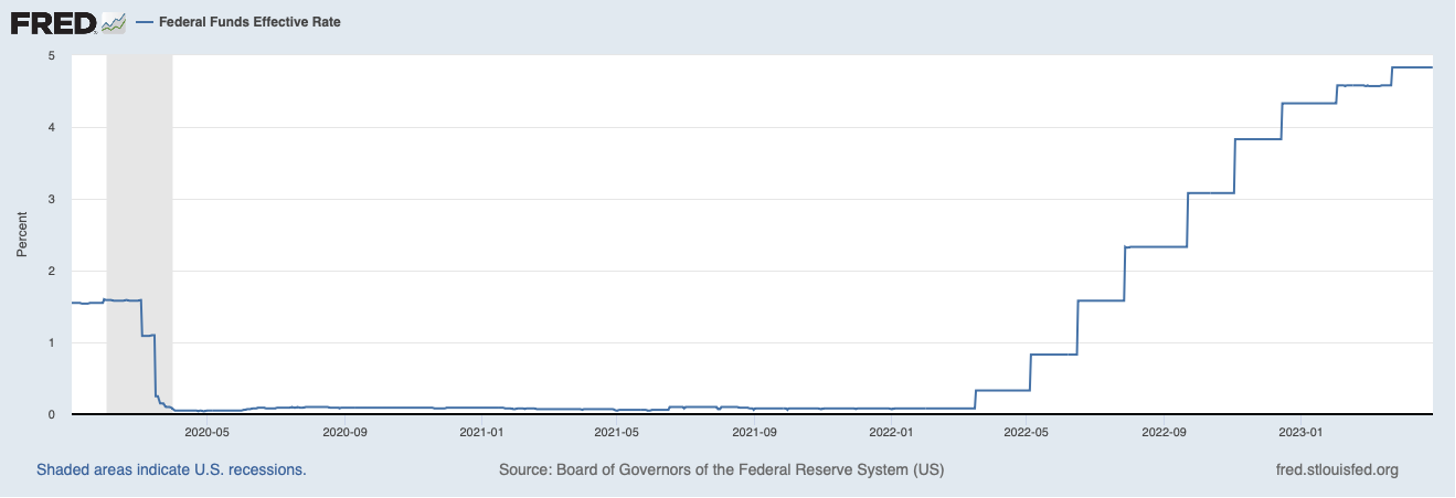
This graph depicts the upward trajectory of the Federal Funds Rate after ‘lift-off’ in Q12022.
With all that I have said so far, I am certainly not going to put my name on any recession predictions. This is not from lack of confidence, but rather a case of wait and see.
My preferred metric, credit to the non-financial sector (sourced from the Bank for International Settlements) is showing a slight decline. However, there is a significant delay between observation and publication (usually about six months). If this remains constant, it follows logically a decline in growth through decline in demand will result in recession and decline in GDP.
China
In China, it was the best of times, it was the worst of times….
China continues to grow economically, albeit at a lesser rate of 4.5% per annum.
This is lower than what economists had predicted and, in light of scepticism of China’s economic health, Chinese stocks have shed $USD550 billion. This precipitous decline underlines the challenges in perpetuating the Chinese miracle.
…China’s Miracle by Design: China’s GDP and Growth for the Future
Recent geopolitical tension between the US and China, with F22 Raptors shooting down alleged Chinese spy balloons and other assorted suspected spy balloons. Along with this, talk of a US – China ‘decoupling’ began to emerge. There is ground for scepticism of these claims, however.
As Peter touched on last month, the global economy is dominated by the US, China, Japan and Germany.
This is (largely) by design which dates all the way back to WWII.
While we don’t have time to get into it here (Yanis Varoufakis’ The Global Minotaur is a great place to start), China is the economic engine of the world and has been to a degree since the 1990s.
While this is accepted by everyone with a pulse, the US and China now demonstrate an extreme depth of interdependence, dreamt up in the late 1940s, which cannot easily be undone.
This continued growth is reliant on continued growth in credit (which skyrocketed after 2008).
This looks likely to continue with credit to the non-financial sector increasing (opposed to a US decline) as of late last year (recalling the six-month delay from observation to release).
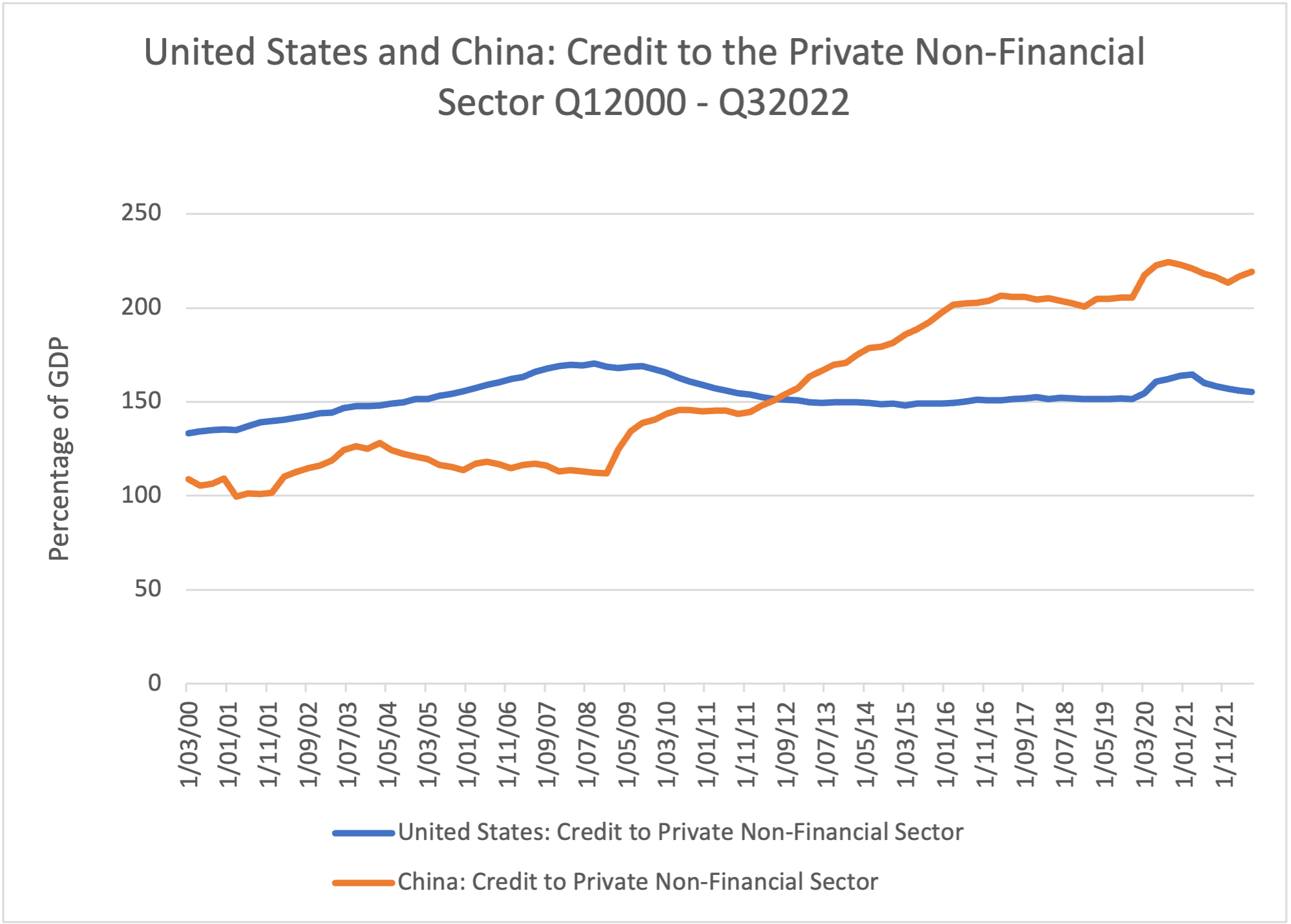
The graph, created with data from the BIS, demonstrates credit to the private non-financial sector for the United States and China as a percentage of GDP. You can see the growth in credit during and after 2008 in China.
For now at least, China will continue to evade economic catastrophe.
United Kingdom
After persistent inflation noted in the last monthly report, UK GDP has been reported to have risen to pre-pandemic levels.
The UK still has tremendous issues with energy diversification, and energy prices remain rather high. The data is graphed below and it is worth seeing.
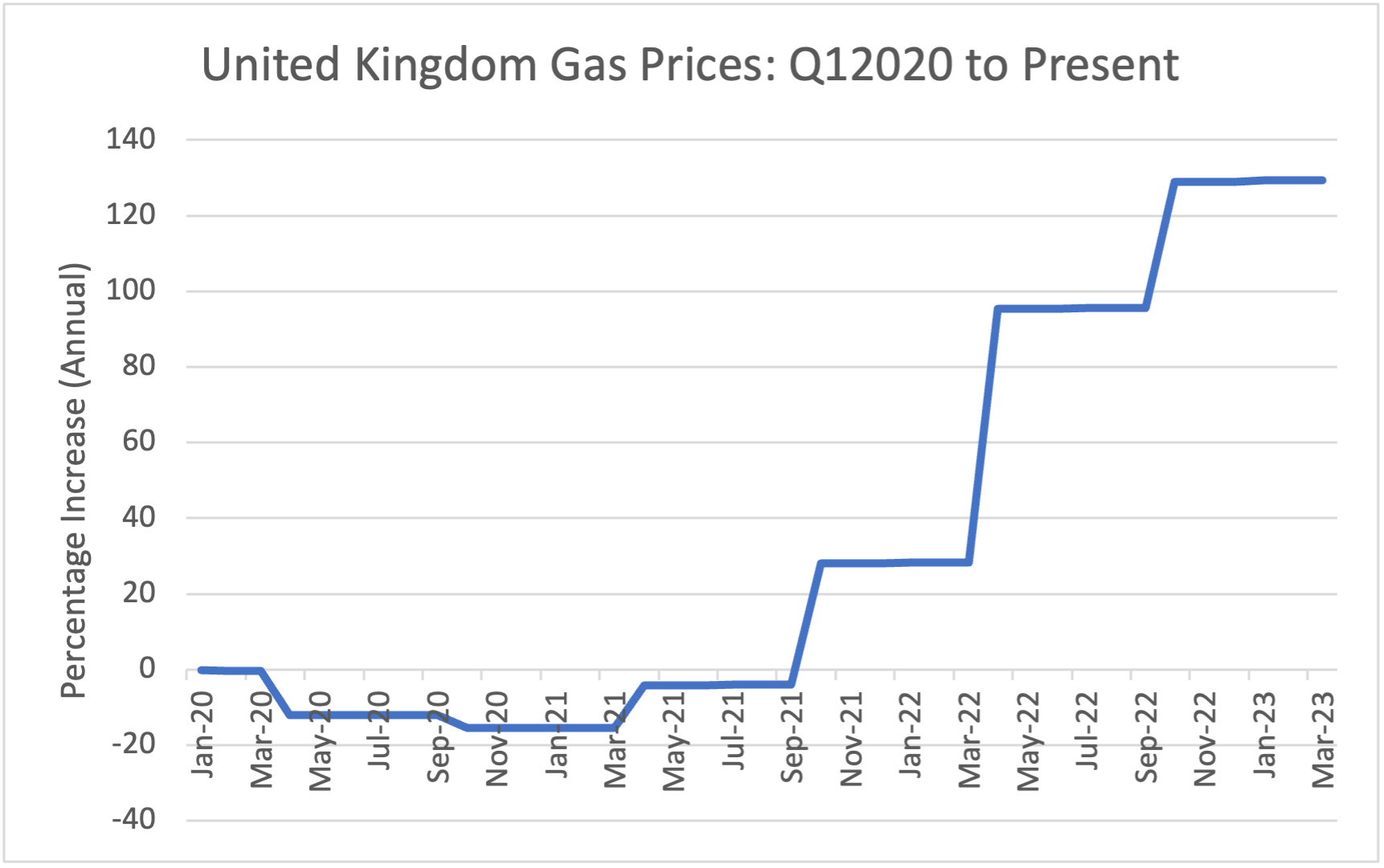
Wow, would you look at that. This graph depicts the gas price increase in the UK. Note the left-hand scale – gas price increases have been in excess of 100%.
With that type of price increase, then it is no surprise inflation remains. If only the Bank of England could produce natural gas! I do not think that this will impact the Coronation, however.
Eurozone
The Eurozone continues to experience similar economic pain inflicted upon the United Kingdom.
In the Euro Area, an uptick in inflation is said by analysts to ‘complicate the decision of the ECB to raise interest rates’.
Again, if only Madame Lagarde could create oil and gas and reopen supply chains!
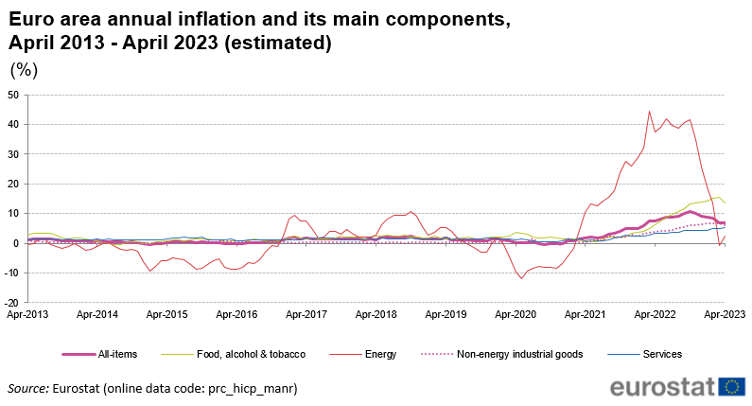
While some aspects may be difficult to see, the graph above illustrates trends for the components of inflation in the Euro Area. You can clearly see that energy price inflation vastly outstrips other components of inflation.
Australia
The Reserve Bank of Australia surprising many across the markets, decided to continue its path of interest rate increases, raising the interest rate to 3.85% on 2 May.
This is in a context of anaemic retail sales growth, which was shown by the Australian Bureau of Statistics (ABS) to have increased by 0.4% in March 2023.
This signifies an annual increase of 5% but, in real terms, this actually indicates an annual decline. Monthly data is shown in the figure below.
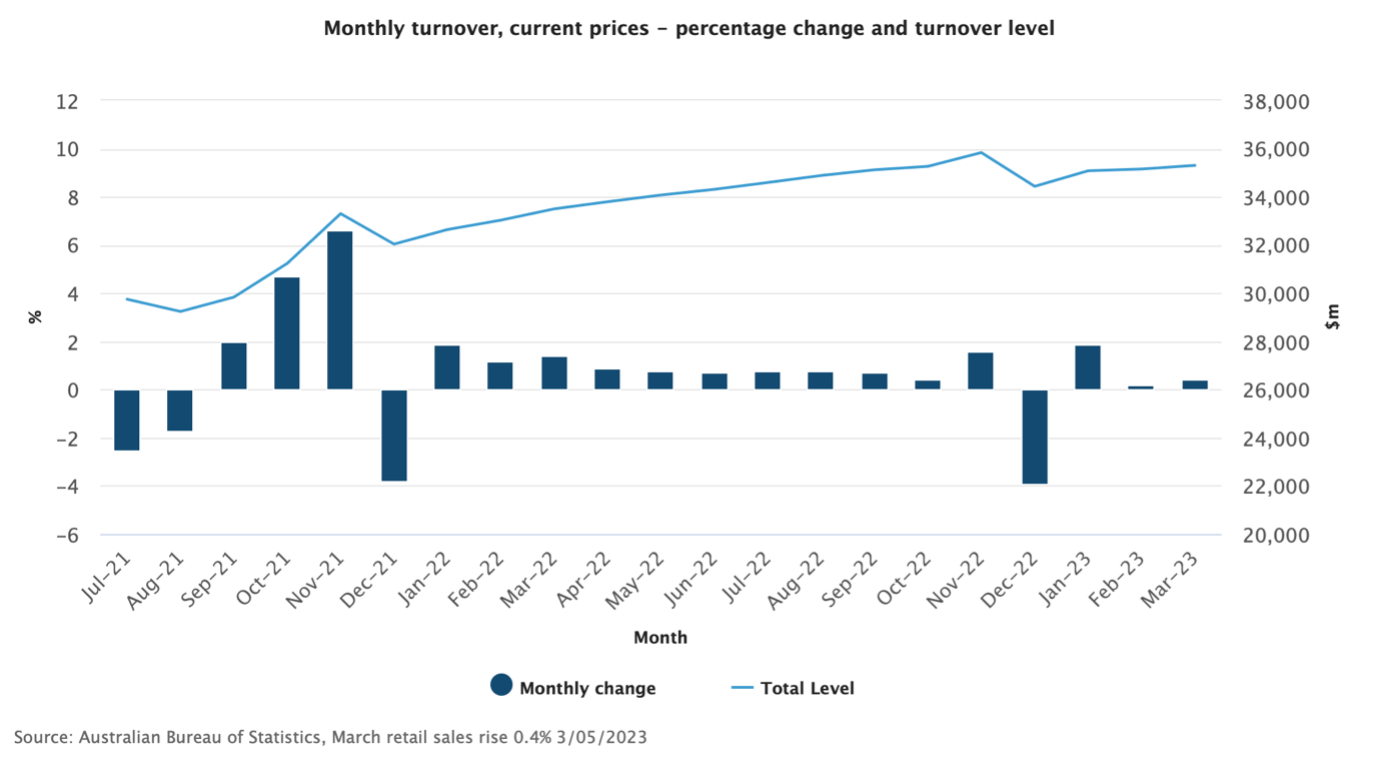
This graph illustrates the total level monthly retail sales (the line measured on the right hand axis) and the monthly percentage change in retail sales volumes depicted by the bar graph and measured on the left hand axis.
To my way of thinking, this illustrates my belief that central bankers are acting from an emotional fear of inflation drilled into them through economics education and work in the dark arts of central banking.
In other words, raising interest rates is to some degree an emotive exercise. I would not be surprised if more central banks (ours included) continue their respective tightening cycles after the music has ended.
New Zealand
The New Zealand Tax Report Revealed a Dark Secret
It didn’t actually.
It has been known for a while that the wealthiest earn more through ‘property income’ (i.e., stocks, fixed interest and – you guessed it – property) as opposed to salaries and wages.
In fact, econophysicists revealed this nearly 20 years ago through rigorous research. The headline here is that there is no headline. The tax system isn’t going to change too drastically soon.
Credit Where Credit is Due
Centrix data continues to show New Zealanders are struggling to keep up with rising interest rates.
Their insights show us that In March 2023, ‘11.8% of the credit active population reported repayment arrears’.
Moreover, ‘mortgage arrears also continued to climb for the eighth consecutive month in March, with 1.31% of residential mortgages (19,300) reported as past due, up 26% year-on-year’.
With regard to everyone’s favourite economic topic – house prices – this data indicates that house prices may continue to decline further. New mortgage lending is depicted in the graph below.
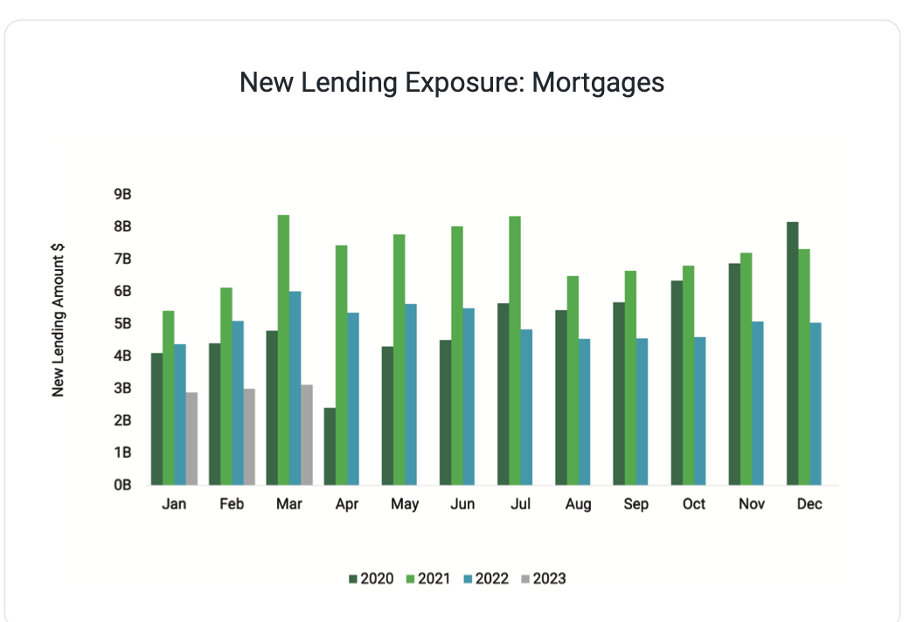
This graph, from Centrix, depicts new mortgage lending exposure. 2023 lending is the furthest bar to the right on January, February and March, and is noticeably lower in previous years.
Low unemployment will continue to buoy hope for good sleep
The latest figures from Stats NZ showed unemployment in New Zealand remained low. Here is the unemployment data.

Here’s New Zealand’s unemployment rate from Q1 2015 to the present where it remains at 3.7%. Although it has been trending upwards lately, it is below the dataset average of 4.33%.
Encouragingly, labour underutilisation is down on previous data (albeit very slightly) and the employment rate itself remains high at 69.6%. Underutilisation data are shown below.
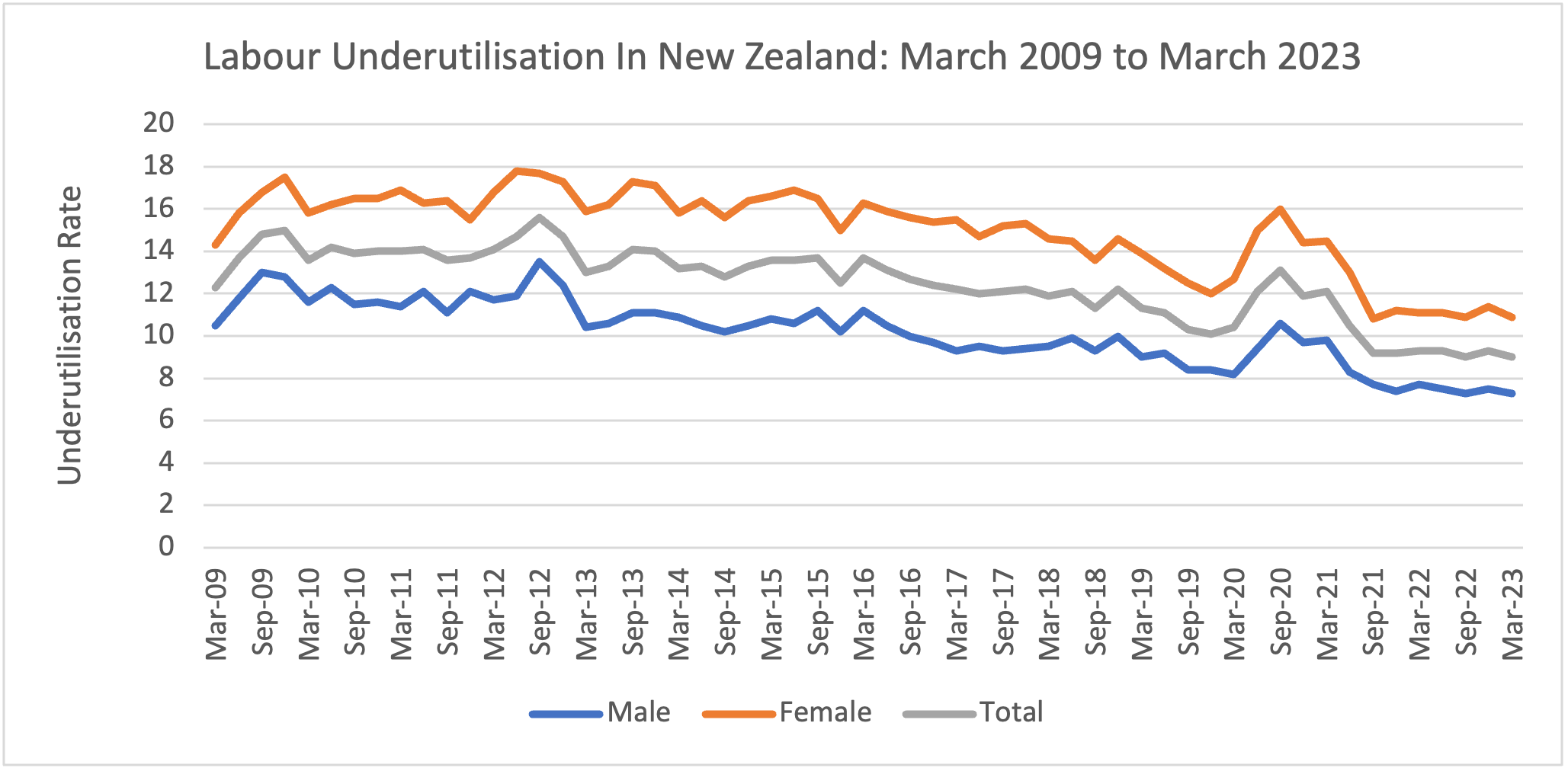
Here’s New Zealand’s underutilisation rate from March 2009 through to the present.
If unemployment were to rise significantly, then policymakers would begin to lose significant amounts of sleep over the impact of unemployment on financial stability. The flip side of the coin remains that businesses still won’t be able to find suitable workers.
Final Thoughts
Markets remain focused on ‘The Fab Four’. This is what may drive trading prices in the short term at least. That may mean ongoing choppy sideways for now.
With some current glimmers of hope close to home, namely persistent low unemployment, the broad outlook for the global economy remains mixed and uncertain at the moment.
I do not see a return to stagflation of the 1970s. That was the result of economic dynamics which were readjusting after the 1960s. This is different, and therefore has differing causes and effects.
The conversation over what drives inflation is changing. Simple manipulation of interest rates just doesn’t cut it anymore, and there is ample reason for this grounded in abundant evidence.
It should be noted that Madame Lagarde has accused firms of ‘greedflation’ in the wake of continued profits and simultaneous inflation. Over the coming months, I would like to expand on these themes.
While likely, I will not put my name to any recession claims yet. Economists have predicted 100 of the past 99 recessions.
Attempts at jokes aside, the more data we get in the future from authorities, the more likely we are to be able to make more informed decisions about the direction of the global economy.
EDITOR’S NOTE: If you have any comments for Morgan or any feedback on this month’s Market and Economic Update, please let us know by emailing invest@wiseplanning.co.nz.
